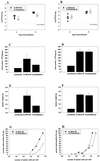Virus reconstituted from infectious bacterial artificial chromosome (BAC)-cloned murine gammaherpesvirus 68 acquires wild-type properties in vivo only after excision of BAC vector sequences
- PMID: 11356978
- PMCID: PMC114283
- DOI: 10.1128/JVI.75.12.5692-5696.2001
Virus reconstituted from infectious bacterial artificial chromosome (BAC)-cloned murine gammaherpesvirus 68 acquires wild-type properties in vivo only after excision of BAC vector sequences
Abstract
We studied the in vivo biological properties of viruses reconstituted from the genome of murine gammaherpesvirus 68 (MHV-68) cloned as an infectious bacterial artificial chromosome (BAC). Recombinant virus RgammaHV68A98.01, containing BAC vector sequences, is attenuated in vivo as determined by (i) viral titers in the lungs during the acute phase of infection, (ii) the extent of splenomegaly, and (iii) the number of latently infected spleen cells reactivating virus in an ex vivo reactivation assay. Since the BAC vector sequences were flanked by loxP sites, passaging the virus in fibroblasts expressing Cre recombinase resulted in the generation of recombinant virus RgammaHV68A98.02, with biological properties comparable to those of wild-type MHV-68. On the basis of these data we conclude (i) that excision of BAC vector sequences from cloned MHV-68 genomes is critical for reconstitution of the wild-type phenotypic properties of this virus and (ii) that the BAC-cloned MHV-68 genome is suitable for the construction of mutants and mutant libraries whose phenotypes can be reliably assessed in vivo.
Figures



Similar articles
-
Cloning and mutagenesis of the murine gammaherpesvirus 68 genome as an infectious bacterial artificial chromosome.J Virol. 2000 Aug;74(15):6964-74. doi: 10.1128/jvi.74.15.6964-6974.2000. J Virol. 2000. PMID: 10888635 Free PMC article.
-
Cloning of herpesviral genomes as bacterial artificial chromosomes.Rev Med Virol. 2003 Mar-Apr;13(2):111-21. doi: 10.1002/rmv.380. Rev Med Virol. 2003. PMID: 12627394 Review.
-
Recombinant murine gammaherpesvirus 68 (MHV-68) as challenge virus to test efficacy of vaccination against chronic virus infections in the mouse model.Vaccine. 2007 May 16;25(20):3934-45. doi: 10.1016/j.vaccine.2007.02.054. Epub 2007 Mar 6. Vaccine. 2007. PMID: 17433507
-
Cloning of the genome of equine herpesvirus 4 strain TH20p as an infectious bacterial artificial chromosome.Arch Virol. 2009;154(5):833-42. doi: 10.1007/s00705-009-0382-0. Epub 2009 Apr 23. Arch Virol. 2009. PMID: 19387789
-
A murine gammaherpesvirus.Acta Virol. 2000 Jun-Aug;44(3):211-26. Acta Virol. 2000. PMID: 11155368 Review.
Cited by
-
In vivo imaging of murid herpesvirus-4 infection.J Gen Virol. 2009 Jan;90(Pt 1):21-32. doi: 10.1099/vir.0.006569-0. J Gen Virol. 2009. PMID: 19088269 Free PMC article.
-
A single CD8+ T cell epitope sets the long-term latent load of a murid herpesvirus.PLoS Pathog. 2008 Oct;4(10):e1000177. doi: 10.1371/journal.ppat.1000177. Epub 2008 Oct 10. PLoS Pathog. 2008. PMID: 18846211 Free PMC article.
-
Flip-Flop HSV-BAC: bacterial artificial chromosome based system for rapid generation of recombinant herpes simplex virus vectors using two independent site-specific recombinases.BMC Biotechnol. 2006 Sep 22;6:40. doi: 10.1186/1472-6750-6-40. BMC Biotechnol. 2006. PMID: 16995942 Free PMC article.
-
A gammaherpesvirus 68 gene 50 null mutant establishes long-term latency in the lung but fails to vaccinate against a wild-type virus challenge.J Virol. 2006 Feb;80(3):1592-8. doi: 10.1128/JVI.80.3.1592-1598.2006. J Virol. 2006. PMID: 16415035 Free PMC article.
-
Identification of cis sequences required for lytic DNA replication and packaging of murine gammaherpesvirus 68.J Virol. 2004 Sep;78(17):9123-31. doi: 10.1128/JVI.78.17.9123-9131.2004. J Virol. 2004. PMID: 15308708 Free PMC article.
References
-
- Britt W J. Infectious clones of herpesviruses: a new approach for understanding viral gene function. Trends Microbiol. 2000;8:262–265. - PubMed
-
- Brune W, Menard C, Heesemann J, Koszinowski U H. A ribonucleotide reductase homolog of cytomegalovirus and endothelial cell tropism. Science. 2001;291:303–305. - PubMed
Publication types
MeSH terms
LinkOut - more resources
Full Text Sources
Other Literature Sources

